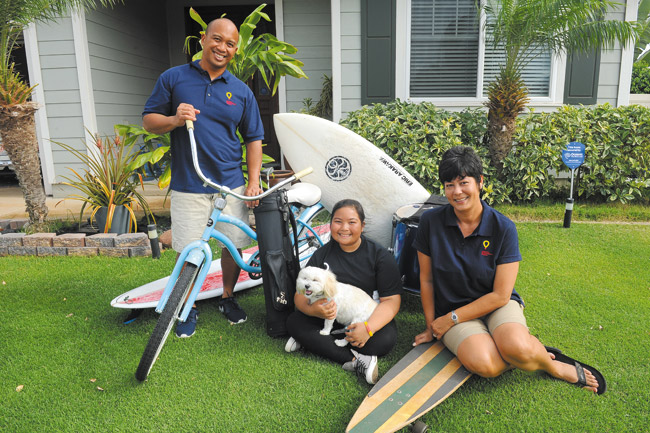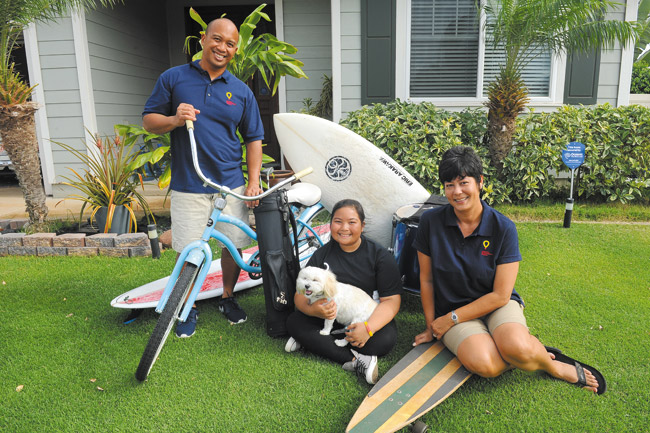One Tough Keiki
At 12, Taylor Tagatac has beaten leukemia twice, and with uncommon strength and grace. That’s why she’s being honored as Hawaii Miracle Network Champion Child
Everyone wants that one-in-a-million chance at winning the lottery, but what happens when you’re that one in a million who strikes a negative in life’s lottery? What happens when the luck of the draw means that you’re one among the rare percentage of children who acquire life-threatening acute myelogenous leukemia (AML)?
mw-nm-042215-taylortagatac-1
Well, if you’re Taylor Tagatac, it means you take those odds, turn them around and emerge a champion.
In 2008, like any child of 5, Tagatac had just started kindergarten, but recurrent fevers had her admitted to Kapiolani Medical Center. Tests came back with the news no parent wants to hear: She had AML, or cancer of the blood cells. She immediately was put on a regimen of chemotherapy sessions and related medical interventions, even necessitating an entire month — and her birthday — in the hospital.
“Chemotherapy was really hard,” recalls Tagatac. “You get all these symptoms like hair loss and rashes, and your stomach isn’t very strong so you puke a lot.”
Her father Frank had to watch his once lively little surfing buddy seemingly deteriorate, and mother Jamy did her best to buffer their only child’s cancer struggle as best as she could.
“One of the hardest things going through all these things with Taylor was to be strong for her,” says Jamy, “to let her know that it’s OK to go feel whatever she is feeling — to be happy or mad or sad — especially when she lost her hair.”
At an age when you think of girls playing dress-up and enjoying having their hair done, Tagatac lost most of hers. On the positive side, she bonded with the staff, made a friend in the hospital’s playroom who she’d play Wii and board games with, and had Mom on hand to help her keep up with schooling. Within six months, all was promising. She had completed her chemo treatments and was in remission.
But lightning struck twice. A checkup one-and-a-half years after receiving the all-clear showed that the leukemia had relapsed. This time, the treatment would be even more intensive, requiring a bone marrow transplant. Normally, a patient requiring the procedure would have been sent to the Mainland for treatment, but Kapiolani hospital recently had participated in national trials for a new treatment technique, and that technique now was available to patients. Taylor would be the first patient to receive it, which meant she would be able to stay in Hawaii, close to the support of family and friends.
In layman’s terms, bone marrow is the substance inside our bones that produces oxygen-carrying, infection-fighting cells that circulate in our blood. In Taylor’s case, those were the very cells that were cancerous. Having a unique tissue type and no siblings or suitable match in the volunteer donor registry or the blood bank, the only choice was to have one of her parents volunteer their bone marrow. However, a parent is only a haploidentical, or a half, match, whereas a full match offers the best chance of success. For the procedure, Dad’s cells were determined to be the best fit.
But finding a donor is only the beginning.
“The problem is a half match is not a good enough match,” says one of Tagatac’s oncologists, Dr. Randal Wada, who also is medical director of the stem cell transplant program at Kapiolani. “The immune cells from that donor are going to attack the body and would most likely kill her if we didn’t do anything about it.”
“Doing something about it” meant administering a high-intensity dose of chemotherapy to kill Taylor’s cancer cells and weaken her immune system, so that her body wouldn’t fight the new, incompatible cells from her father. After the transplant, Tagatac underwent additional chemotherapy to eradicate immune cells from her father’s bone marrow that might attack her own body. Chemotherapy kills off rapidly dividing cells, and the cells that would be multiplying to react and attack their new environment would be dad’s immune cells.
“The transplant process itself can take a couple of months,” notes Wada, “but the follow-up, dealing with potential complications and toxicity of the transplant, can take several months to even years of ongoing issues.”
Tagatac’s body did react strongly against the foreign bone marrow, requiring medications, dietary counseling and physical and occupational therapy. Chemotherapy destroys the immune system, so that during her first bout with cancer, any sign of sickness or fever required that she go straight to the hospital. This time around, her compromised immune system mandated that she remain in isolation at the hospital for two months.
“The first time I had leukemia,” says Tagatac, “all my friends and teachers would come and visit me and say hi. But the second time, I couldn’t go out and nobody could come in except for the nurses and doctors and my parents. When I was healthy enough, halfway through my treatments, Tucker (Kapiolani’s therapy dog) and the playroom staff would come and give me toys and games so I wouldn’t feel so down and lonely and bored.”
On the bright side, while biding her time, Tagatac picked up an interest in watching the Food Network. Since preventative measures meant she couldn’t go out in public much, or even eat out while recovering, she developed a fondness for cooking. Even brighter news is that today, three-and-a-half years after the transplant, Tagatac is leukemia-free and home with Mom, Dad, their three dogs and pet tortoise.
Though Tagatac will continue receiving regular checkups to monitor for long-term side effects, after all that sickness and confinement, Tagatac loves activities that smack of freedom. She’s surfing again, horseback riding, riding her bicycle and skateboard, and playing drums. And after four years of homeschooling with mom, she has a group of school friends again. She started seventh grade this school year at Ewa Makai Middle School, she plays percussion in the school band and has enjoyed getting to know her classmates, especially a close friend she watches movies and goes shopping with.
There’s something else that’s been keeping Tagatac busy lately. Of the thousands of families that are treated at Kapiolani, Tagatac was nominated by the staff to be this year’s Hawaii Children’s Miracle Network Champion. Her championship is being announced today (April 22) in a 2:30 p.m. ceremony at Marriott’s Ko Olina Beach Club, with hospital personnel, sponsors and community leaders all recognizing Tagatac’s courage throughout her ordeal.
“I’m the spokesperson representing Hawaii, so in June I get to go to Atlanta and Washington, D.C., to meet the rest of the Champion children, and next February, we’re going to Orlando.”
She will be meeting a child from every state and province in the U.S. and Canada, all of whom have overcome severe medical challenges. In Washington, Tagatac and the rest of the children will meet fellow Oahuan President Obama, who has been very welcoming of the CMN children each year.
For her parents’ part, they are exceedingly thankful to Kapiolani hospital for being so supportive in their hardest of times, and “treating us like family,” says Mom. Jamy, a bartender at Ko Olina Beach Club, and Frank, regional coordinator for Armed Forces
Entertainment, tallied up the medical expenses they would have accrued had Kapiolani Children’s Miracle Network not been there to help. If not for CMN, the cost would have exceeded $3 million. It’s devastating to picture a scenario without CMN. Even with their child’s life depending on it, very few parents could afford such an expense. (To support our local CMN facility, where 100 percent of all donations help Hawaii’s keiki, visit kapiolanigift.org or address mail to Kapiolani Children’s Miracle Network, 55 Merchant St., Suite 2600, Honolulu, HI 96813.)
If there’s a silver lining to her tribulations, Tagatac knows what it means to endure medical hardship, and she wants to help others. When asked what she wants to be when she grows up, without missing a beat, she declares: “Pediatric oncologist.”
“I just couldn’t be prouder of Taylor and the beautiful girl she’s become,” says Mom. “We’re very close because of what we’ve been through. I feel Taylor can talk to me about anything, and that has really strengthened our bond.”
“I’m very proud of Taylor,” agrees Dad. “She’s come a long way.”







